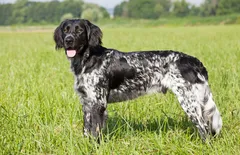
Basset Hound
The basset hound is likely the shortest large dog breed. And they are generally mild-mannered.
Overall Status
| Height | No more than 14 inches |
| Temperament | Friendly, Easygoing, Naturally well-behaved |
| Weight | 50 to 65 pounds |
| Life Expectancy | 12 to 15 years |
| Coat Color | Black and Tan, Brown, Gray, Red, Tricolor, White |
| Barking Level | Likes To Be Vocal |
Quick Factors
| Playfulness | |
| Dog Friendly | |
| Exercise Need | |
| Grooming Needs | |
| Strangers Friendly | |
| Family Affectionate |
Daily Care
Grooming Tips
The Basset has a short coat that requires daily care because it sheds heavily. Brush it with a rubber curry brush daily if you want to keep all the loose hair under control. The brush removes dead hairs that would otherwise end up on your floor, furniture, and clothing.The oily Basset coat gives the dog a “houndy” odor. Some people like it, some people loathe it. If you’re a loather, you can bathe your Basset weekly to reduce the smell, but it will never completely go away.Check the ears on a weekly basis for signs of infection, irritation, or wax build up. Cleanse regularly with a veterinarian-approved cleanser and cotton ball. Brush the teeth at least once per week to prevent tartar buildup and fight gum disease. Additionally, nails should be trimmed once per month if the dog does not wear down the toenails naturally.
Exercise Tips
Although Basset Hounds might look like couch potatoes, quite the opposite is true. They need regular daily exercise and they enjoy spending as much time in a garden as possible, but fencing has to be very secure because if a Basset Hound picks up a scent and they can escape out of a garden, they will.However, puppies only need a little daily exercise to begin with, because long walks would put too much pressure on their growing joints and bones which could lead to serious problems later in their lives. Twenty minutes play in the garden when the weather is fine is all that puppies really need, but as soon as they have had all their vaccinations, they can be taken out for short walks so they get to meet new people, other dogs and new situations which would help them grow into well-rounded, confident adult dogs.Short (15-20 minute) to medium (up to 30) walksLong walks (40+) occasionallyHikesChasing games
Feeding Tips
Basset Hounds generally have very healthy appetites which means if they are not given the right amount of exercise on a daily basis, these dogs are prone for putting on too much weight. Both puppies and adult Basset Hounds need to be fed a good quality, well-balanced diet throughout their lives making sure it suits the different stages of their lives.If you get a Basset Hound puppy from a breeder, they would give you a feeding schedule and it's important to stick to the same routine, feeding the same type of food to avoid any tummy upsets. You can change a puppy's diet, but this needs to be done very gradually always making sure they don't develop any digestive upset and if they do, it's best to put them back on their original diet and to discuss things with the vet before attempting to change their diet again.`Learn about which human foods are safe for dogs, and which are not. Check with your vet if you have any concerns about your dog’s weight or diet. Clean, fresh water should be available at all times. Like many large breeds, Saint Bernard can experience bloat, a life-threatening condition where the stomach distends and twists. The causes of bloat aren’t fully understood, but experts agree that multiple, small meals per day and preventing vigorous exercise around mealtimes may help reduce the chances of it happening.
Health Tips
The average lifespan of the Basset is 10 to 12 years. Because of the Basset’s ears are long and droopy, it’s important to check them frequently to ensure that air circulation hasn’t led to aninfection. Shaking the head or scratching at the ears may indicate the need for a vet visit. Responsible breeders check for health conditions such aship dysplasia, elbow dysplasia, glaucoma, hypothyroidism, bleeding disorders, and luxating patella, a dislocated kneecap once called a “trick knee” in humans. Brushing your dog’steethwith specially formulated canine toothpaste at least twice a week is also a vital part of Basset health care.
Trainability
Basset Hounds are very independent, and training the breed can be a challenge. Over the centuries, scenthounds of this type were developed to hunt on their own and to follow a track without distraction. Because of this, they can seem aloof and not interested in following your commands. However, a Basset definitely can be trained—it will just take time, consistency, and persistence. Using treats andearly socializationin puppyhood is crucial, and as the Basset matures he and his owner can benefit from continued positiveobedience training.Puppies should be properly socialized to develop the amiable, outgoing personality that is characteristic of the breed. They’re successful in performance and companion events such as earthdog, barn hunt, obedience, and agility.
History
Basset Hounds were originally bred in France and Belgium (“basset” is French for “low”). It is thought that the friars of the Abbey of St. Hubert were responsible for crossing strains of older French breeds to create a low-built scenting hound that could plod over rough terrain while followed on foot by a human hunting partner tracking rabbit and deer. Their accuracy and persistence on scent made Bassets a popular choice for French aristocrats, for whom hunting was a way of life.Bassets first came to the United States in the early 19th century, and the American Kennel Club began registering them in 1885. Bassets became well known in the 1960s after starring in an ad campaign for Hush Puppy shoes, and their popularity increased dramatically. The breed currently ranks 36th in AKC registrations.






